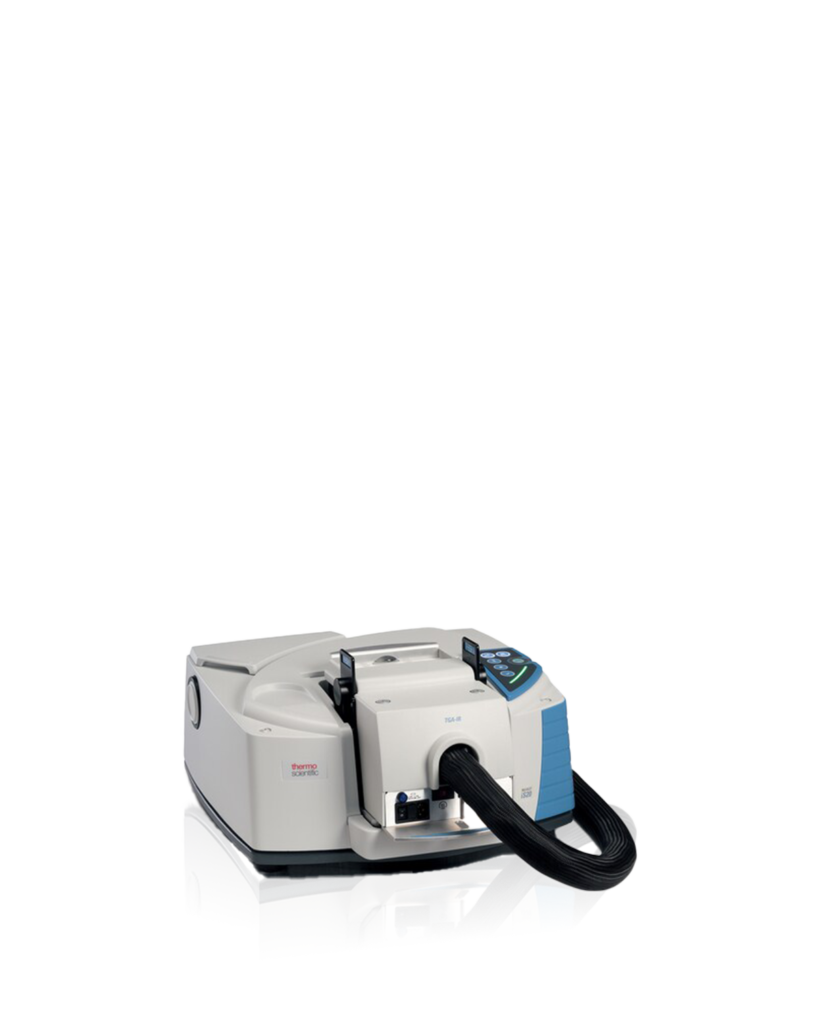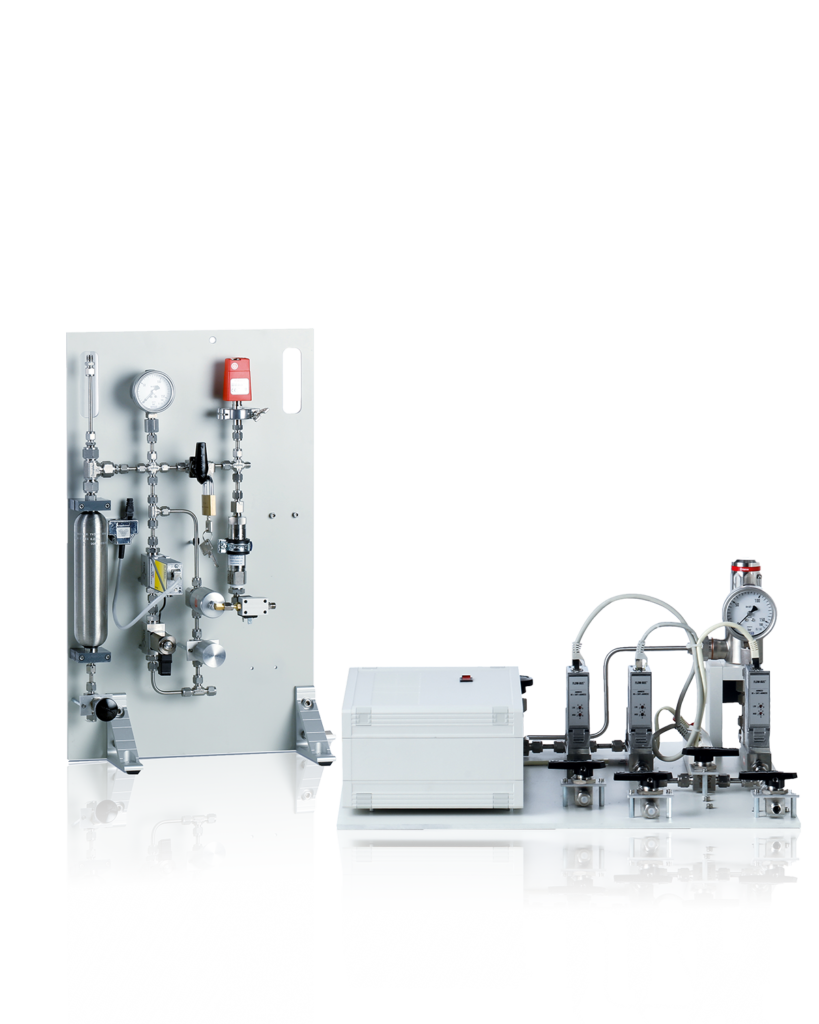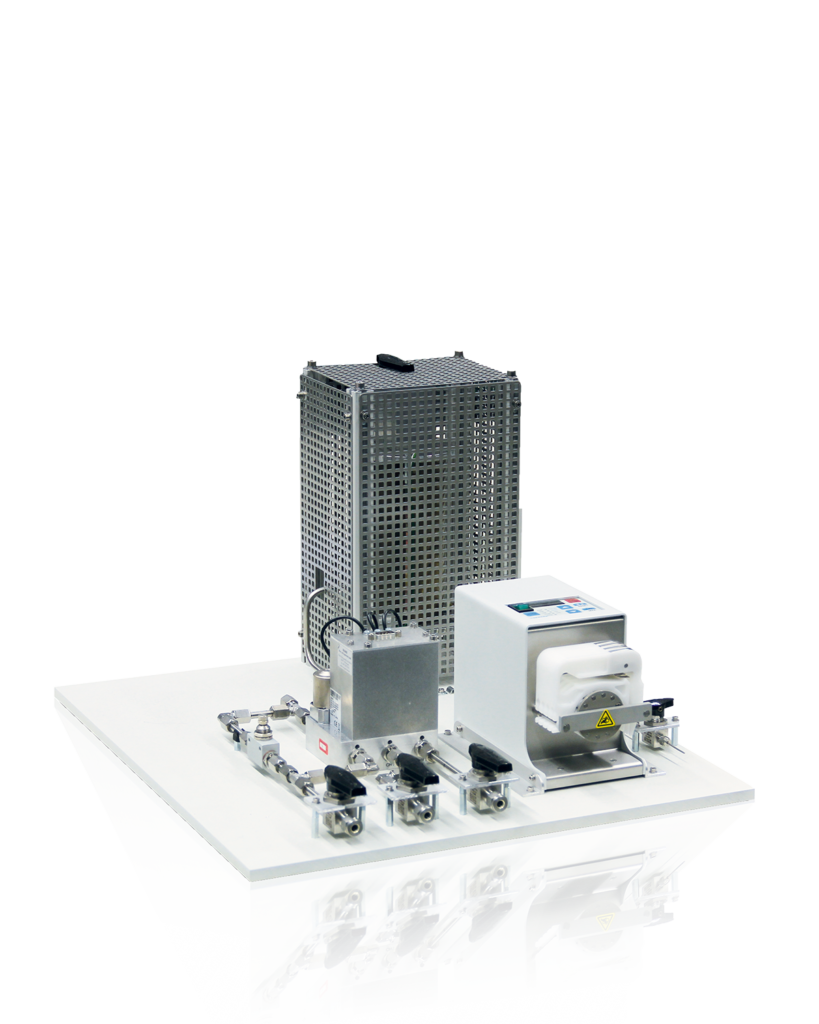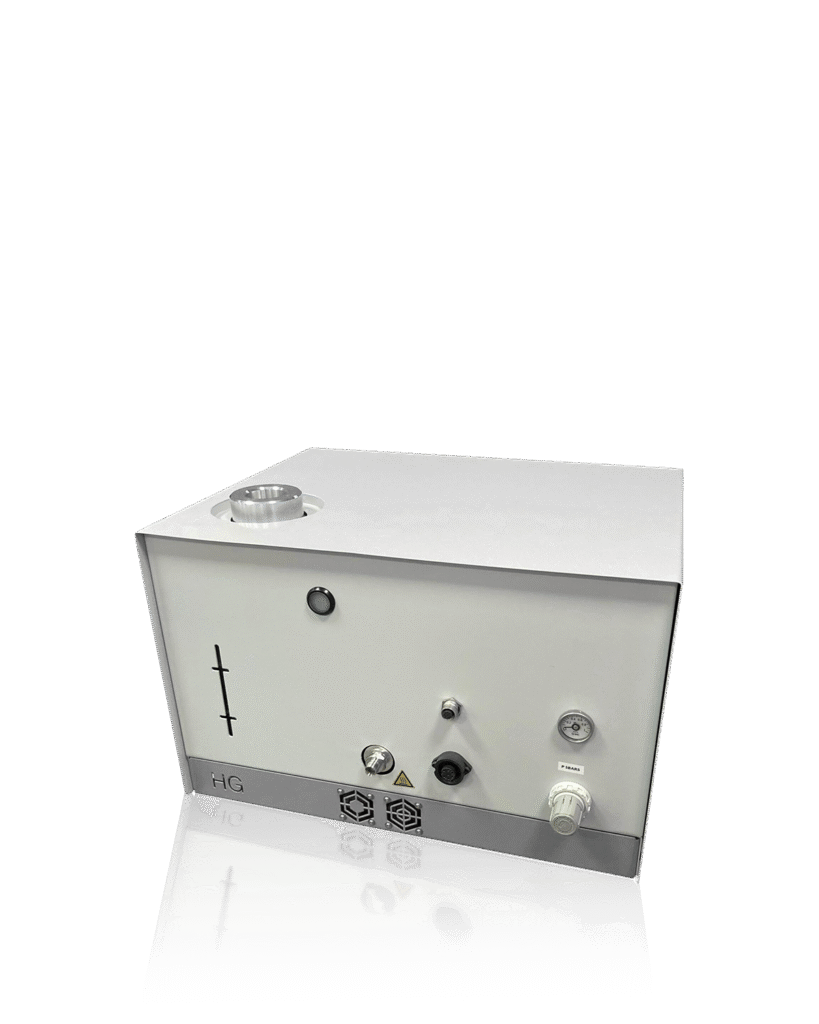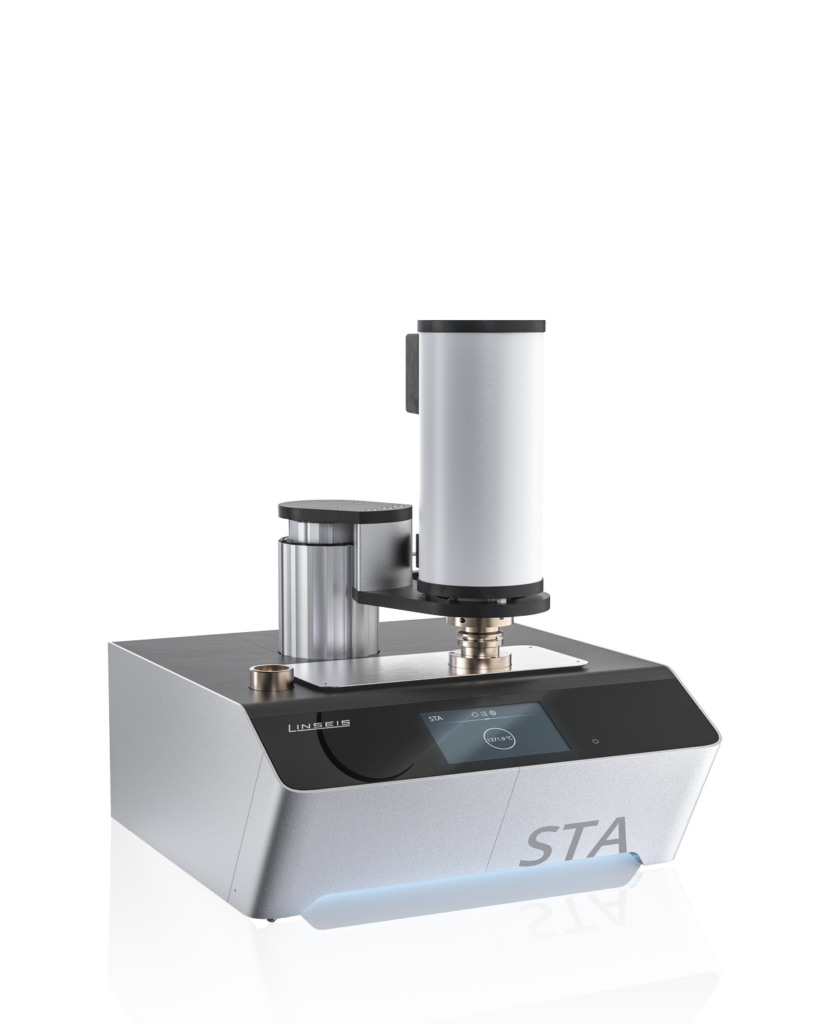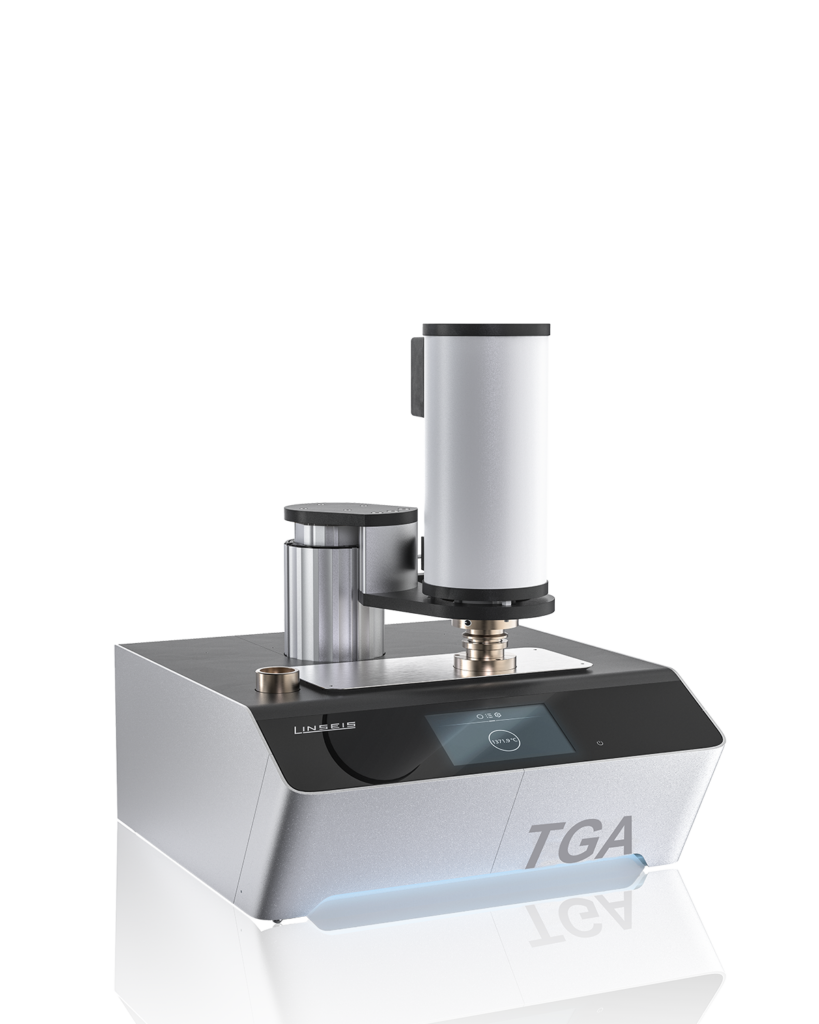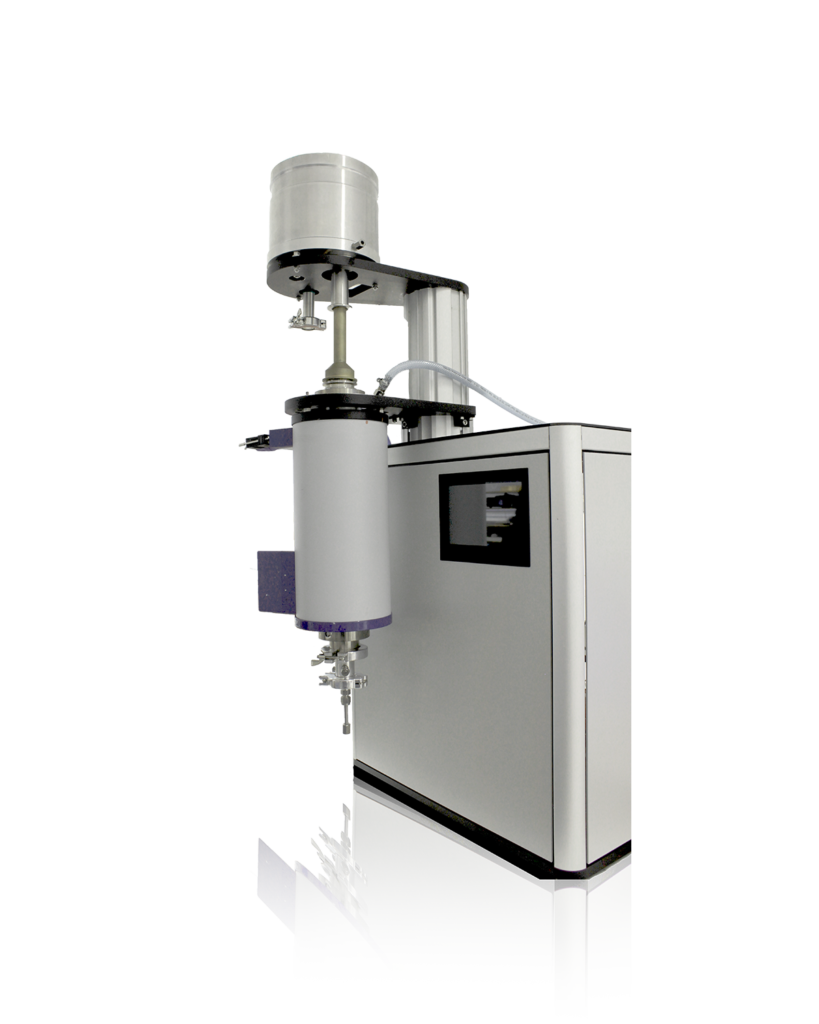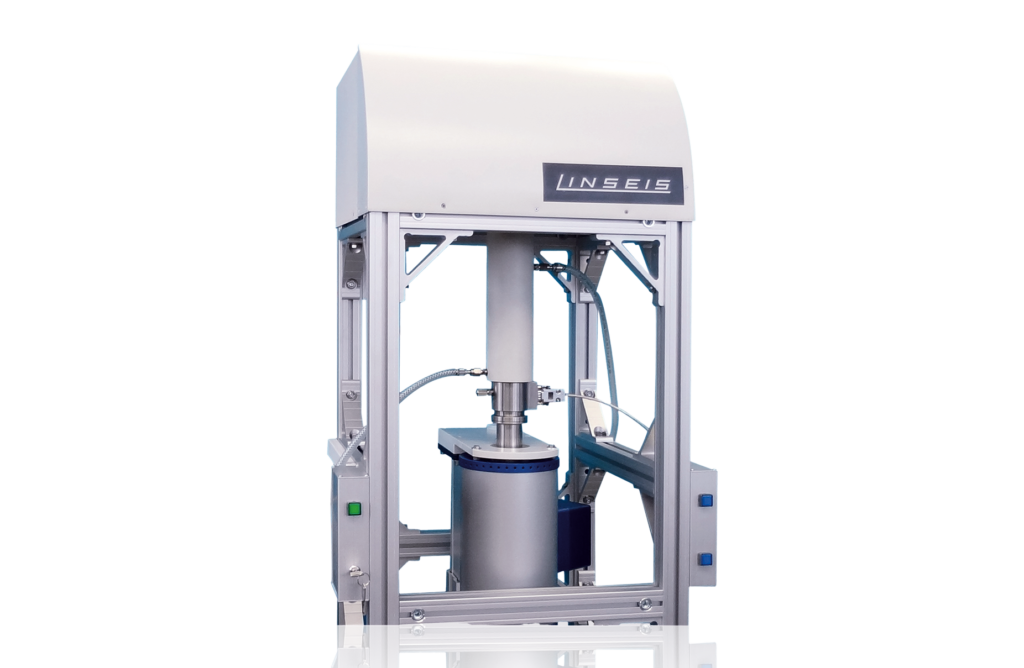TGA L87 MSB: Thermogravimetric Analysis with Magnetic Suspension Precision
The LINSEIS TGA L87 MSB is an advanced thermogravimetric analyzer based on magnetic suspension balance technology, enabling highly precise mass measurements under extreme conditions.
Its unique design allows fully contact-free weighing, separating the sensitive microbalance from high-temperature, high-pressure, or reactive gas environments — ensuring maximum protection and measurement accuracy.
With a temperature range from –196 °C up to 2400 °C and pressures up to 350 bar, the system supports operation in inert, oxidizing, reducing, and reactive atmospheres, as well as vacuum.
Optional gas and vapor control modules, Evolved Gas Analysis (EGA) coupling, and humidity regulation extend the system’s flexibility for demanding applications.
These capabilities make the TGA L87 MSB ideal for advanced material research, gas adsorption and desorption studies, catalyst testing, and thermal analysis under real process conditions.
The LINSEIS TGA L87 MSB operates in full compliance with international standards, including
ASTM E 914, E 1131, E 1868, DIN 51006 and ISO 7111, 11358
ensuring reliable, reproducible, and standardized measurement performance across laboratories worldwide.
Unique Features

Magnetic Suspension Balance (MSB) Technology
At the heart of the TGA L87 MSB lies a contact-free weighing system based on a magnetic suspension coupling.
This unique design separates the sensitive microbalance from the sample chamber, allowing measurements under extreme temperature, pressure, and atmosphere conditions while maintaining exceptional accuracy and long-term stability.
Wide Temperature and Pressure Range
Perform thermogravimetric measurements from –196 °C up to 2400 °C and up to 350 bar.
This makes the L87 MSB ideal for applications in gas adsorption, desorption, and reaction kinetics under realistic process conditions.
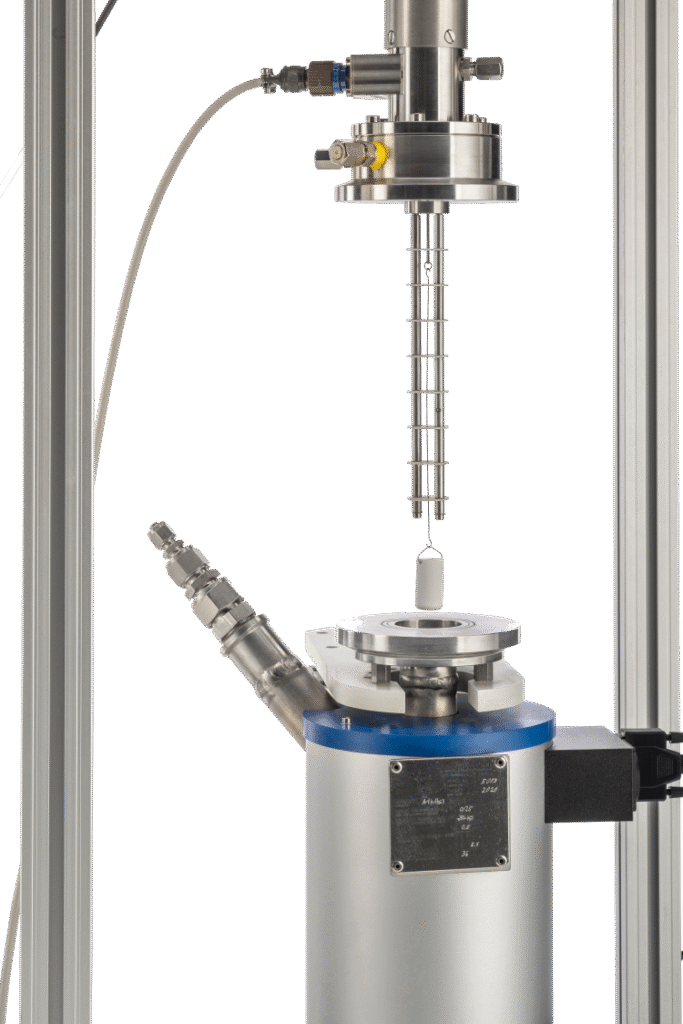
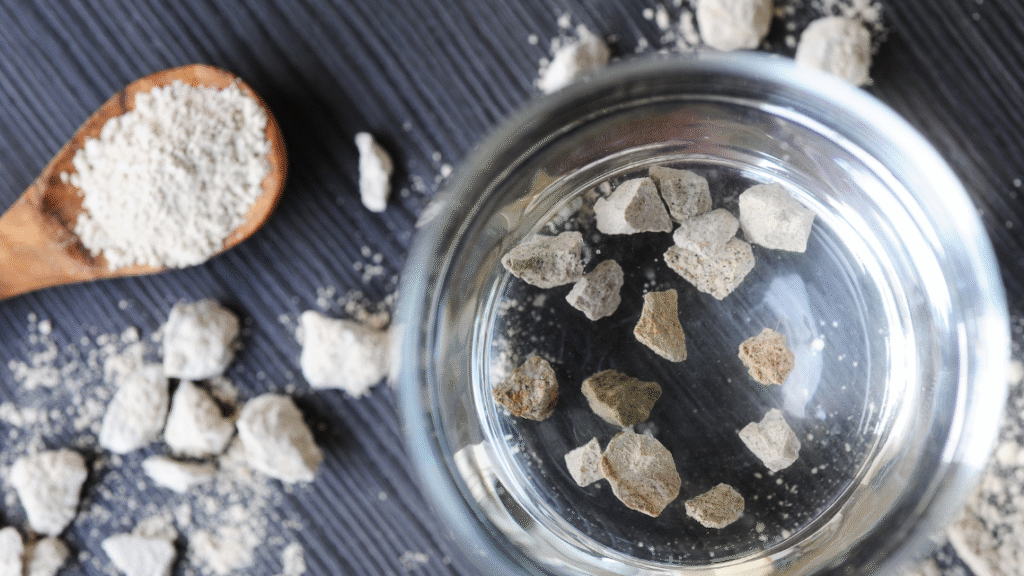
Hermetically Sealed Measuring System
The non-contact coupling enables a fully isolated balance—protecting the weighing mechanism from reactive gases, temperature fluctuations, and mechanical stress for maximum durability and reliability.
Furnace with Optical Ports
Integrated optical access points enable in-situ observation and spectroscopic analysis during experiments, offering new insights into material behavior under reactive or high-pressure environments.
Controlled Gas and Vapor Atmospheres
The optional multi-line gas and vapor control system allows precise adjustment of flow rates, gas composition, and humidity, including water vapor operation.
This ensures complete flexibility for the investigation of gas–solid interactions, catalytic reactions, and sorption processes.
Linseis Lab Link
With Linseis Lab Link, we offer an integrated solution for eliminating uncertainties in measurement results. With direct access to our application experts via the software, you receive advice on the correct measurement procedure and how to evaluate the results. This direct communication ensures optimal results and maximizes the efficiency of your measurements for accurate analysis and research and a smooth process flow.
Safety System for Hydrogen and Reactive Gases
The integrated gas safety concept provides real-time monitoring, automatic shutdown, and optional burn-off functionality — ensuring secure operation even with hydrogen or CO atmospheres.
High-Speed Data Acquisition & Evolved Gas Analysis (EGA)
Modern electronics record temperature, pressure, and mass changes synchronously with high temporal resolution.
The system supports coupling with MS, FTIR, or GC for detailed evolved gas analysis during decomposition or reaction processes.
Fully Customizable Configurations
Each TGA L87 MSB can be tailored to specific research requirements — from furnace type and dosing systems to gas control setups — providing a truly modular platform for advanced thermal analysis.
Highlights



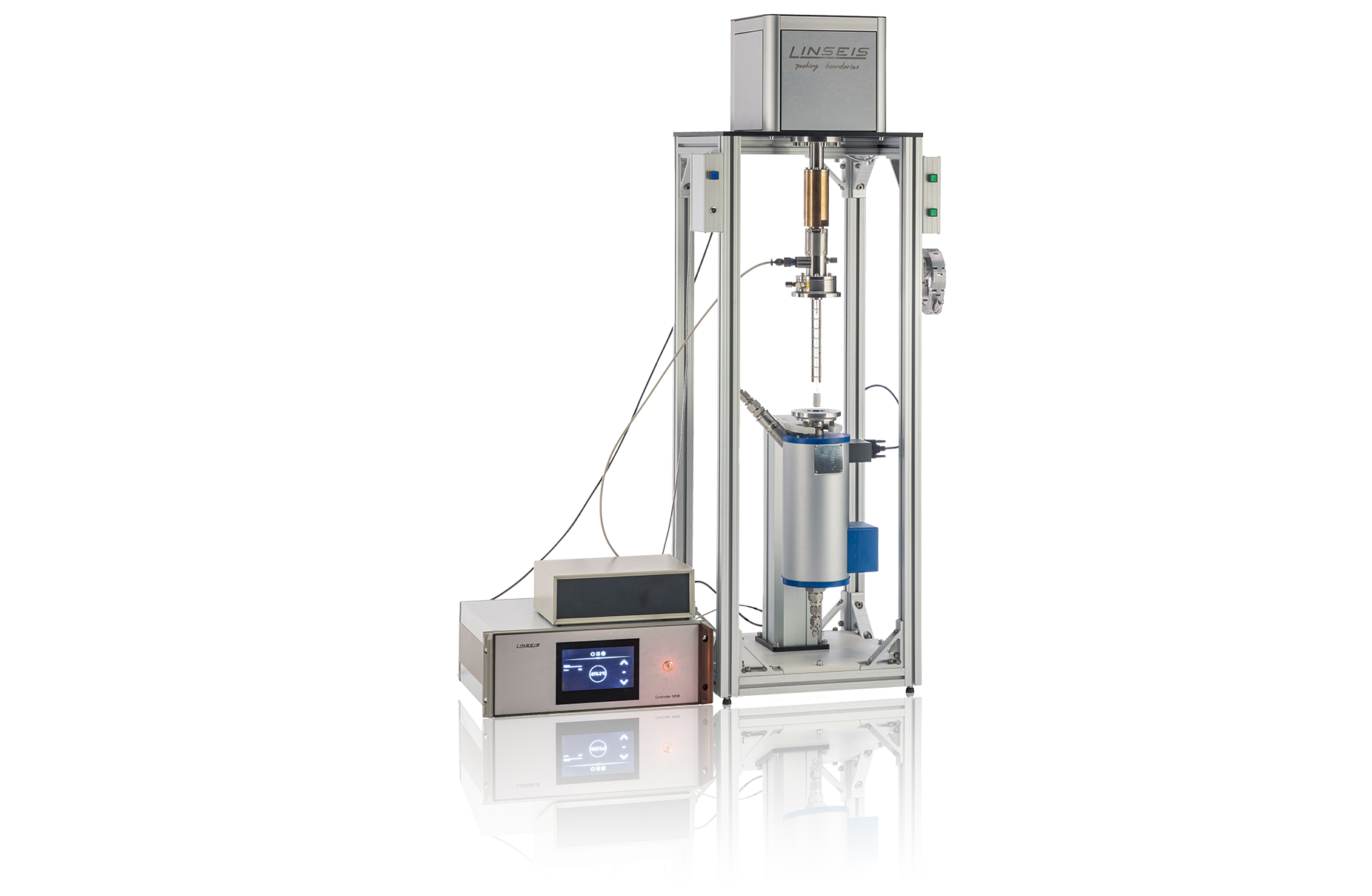
Wide temperature range
High resolution
and accuracy
Modular design
Versatile application possibilities
Key Features

Magnetic Suspension Balance – Contact-Free Precision
The TGA L87 MSB features a unique magnetic suspension system that fully separates the balance from the sample environment.
This contact-free weighing principle ensures highly accurate mass determination even under extreme temperature, pressure, or reactive gas conditions.

Extreme Operating Range – From Cryogenic to High Pressure
With a temperature range from –196 °C to 2400 °C and pressures up to 350 bar, the system enables experiments under true process conditions.
This versatility allows research into gas–solid reactions, adsorption phenomena, and material behavior across an unparalleled range of environments.

Controlled Gas and Vapor Atmospheres
Multiple gas and vapor lines with independent flow and pressure control enable precise adjustment of experimental atmospheres.
From inert to reactive gases and water vapor, the TGA L87 MSB provides maximum flexibility for kinetic and sorption studies.

Integrated LINSEIS platform
The integrated LINSEIS software offers a comprehensive solution that combines hardware and software for maximum process reliability and precision. The standardized platform enables seamless integration of components and devices from external partners – for a particularly robust and reliable overall system.
Questions? Just give us a call!
+1 (609) 223 2070
+49 (0) 9287/880 0
Thursday from 8 am to 4 pm
and Friday from 8 am to 12 pm.
We are here for you!
Specifications

Pressure range: up to 350 bar

Temperature range: –196 °C to 2400 °C

Sample mass: up to 25 g
Discover our high-performance TGA – developed for thermogravimetric analysis under extreme conditions:
- Balance resolution: 10 µg / 1 µg for ultra-precise mass determination
- Atmospheres: inert, oxidizing, reducing, reactive or vacuum (down to 10⁻⁵ mbar)
- Gas and vapor control: modular MFC system for precise multi-gas dosing, humidity and vapor regulation
- EGA coupling: optional interface for MS, FTIR or GC to analyze evolved gases in real time
- Optical ports: integrated windows for in-situ observation and spectroscopic measurements during experiments
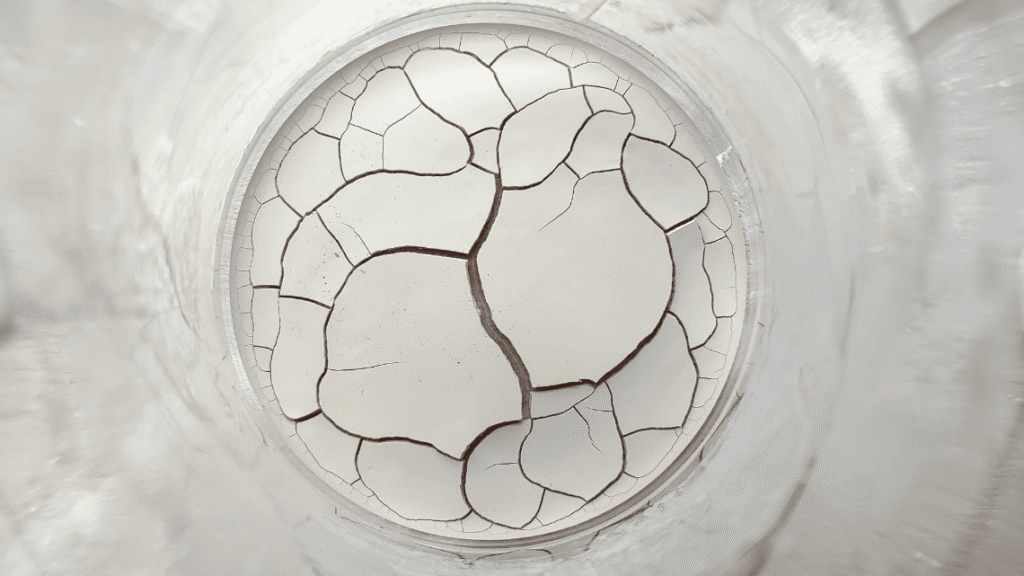

Magnetic Suspension Balance – Contact-Free Precision Under Extreme Conditions
At the heart of the LINSEIS TGA L87 MSB lies its unique magnetic suspension balance technology, enabling fully contact-free weighing across an unmatched range of experimental environments.
By magnetically coupling the sample holder to the external microbalance, the sensitive weighing system is completely isolated from heat, pressure, and reactive gases.
This innovative design ensures maximum protection, long-term stability, and sub-microgram precision, even under extreme conditions such as high-pressure hydrogen atmospheres or temperatures up to 2400 °C.
The result: reliable, reproducible, and contamination-free measurements — ideal for advanced material research, gas–solid interaction studies, and catalytic process investigations.
Recommended Equipment
EGA - Evolved Gas Analysis
Gas Dosing & Gas Safety
Water Vapor & Relative Humidity
Method
Thermogravimetry using Magnetic Suspension Balance Technology
Thermogravimetric Analysis (TGA) measures the change in sample mass as a function of temperature or time under a controlled atmosphere.
In the LINSEIS TGA L87 MSB, this method is implemented through a magnetic suspension balance, which enables contact-free weighing of the sample across a wide range of temperatures, pressures, and gas compositions.
The sample is magnetically coupled to an external microbalance, allowing the measuring chamber to be hermetically sealed from the sensitive balance system.
This unique setup permits highly accurate measurements under inert, oxidizing, reducing, reactive or vacuum conditions, as well as at pressures up to 350 bar and temperatures up to 2400 °C.
The method provides precise insights into decomposition, oxidation, reduction, adsorption, and desorption processes under real process conditions.
By quantifying these mass changes, TGA with magnetic suspension technology enables the determination of material composition, evaluation of thermal stability, and characterization of gas–solid interactions.
This makes it an indispensable tool for advanced material research, catalysis studies, gas storage analysis and high-pressure thermochemical investigations.

Functional Principle of the TGA L87 MSB
The TGA L87 MSB determines changes in sample mass as a function of temperature or time under precisely controlled atmospheric and pressure conditions.
Unlike conventional thermogravimetric analyzers, the MSB employs a magnetic suspension balance, enabling contact-free weighing of the sample inside a sealed reaction chamber.
During measurement, the sample holder is magnetically coupled to an external microbalance, allowing the balance to remain completely isolated from high temperature, high pressure, or chemically reactive environments.
This design ensures exceptional stability and protection of the weighing system while maintaining microgram-level precision even under extreme experimental conditions.
Mass changes caused by decomposition, oxidation, reduction, adsorption or desorption are continuously recorded throughout the entire temperature or pressure cycle.
The resulting data provide detailed insight into reaction kinetics, material stability, gas–solid interactions and process behavior under real operating conditions.
With its advanced furnace design, gas and vapor control systems, and wide operating range up to 2400 °C and 350 bar, the LINSEIS TGA L87 MSB delivers reliable, reproducible, and high-resolution results for demanding research and industrial applications.
Measured variables with Thermogravimetry
Possibilities of thermal analysis using thermogravimetry (TG):
A head start with the TGA L87 MSB – magnetic suspension balance technology for ultimate precision
Questions? Just give us a call!
+1 (609) 223 2070
+49 (0) 9287/880 0
Thursday from 8 am to 4 pm
and Friday from 8 am to 12 pm.
We are here for you!
TGA L87 MSB explained – function, use and capabilities
Measuring Principle

Default Position
In the standby position, both the lower cage and the upper cone rest on the support of the measuring system. No weighing is performed in this state, ensuring system stability and readiness for operation.
Calibration Position
During calibration, the cone is magnetically coupled and held
within the cage, causing only the upper suspension rod to levitate.
This allows precise determination and calibration of the balance signal under defi ned conditions.
Measurement position
In the measurement mode, the magnetic coupling lifts both the cage and the sample holder. The complete sample weight is transmitted to the balance, enabling accurate and reproducible measurement of the sample mass under real experimental conditions.
Forced Flow
Forced-flow offers several advantages in the investigation of gas/solid phase reactions
Patent pending
- Controlled Conditions: Precise control of reaction conditions for a reproducible environment.
- Faster Reaction Times: Acceleration of slow reactions through continuous flow.
- Better Mixing: Uniform distribution of reactants for improved reaction kinetics.
- Scalability: Easier adaptation to different volumes and flow rates for optimized production.
The illustration on the left shows a schematic representation of the weight measurement of a TGA L87 MSB.
The image on the right shows the principle of forced flow operation in a magnetic suspension balance. The sample gas is passed completely through the solid material and exits at the top. This significantly optimises the reproducibility, reaction control and significance of the measurement results.
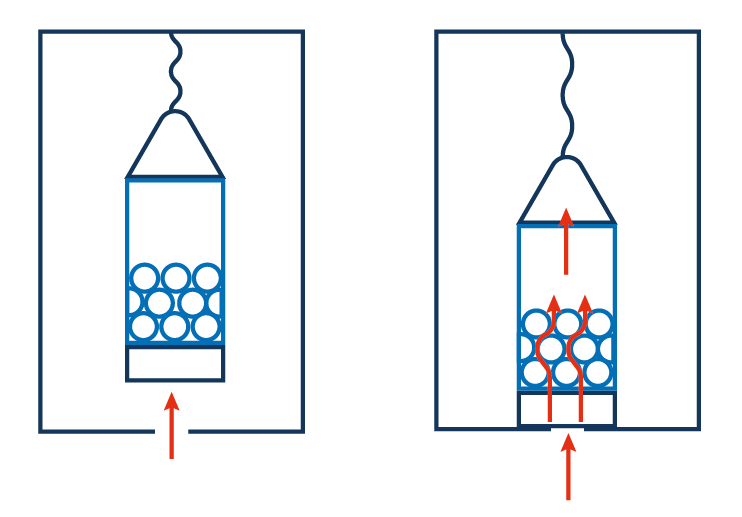
What is the TGA L87 MSB used for?
The TGA L87 MSB is used to measure changes in sample mass as a function of temperature, time, and gas atmosphere.
It is ideal for studying decomposition, oxidation, reduction, adsorption, and desorption processes — especially under extreme conditions such as high pressure, reactive gases, or elevated temperatures.
What makes the TGA L87 MSB different from conventional TGA systems?
Unlike standard thermobalances, the MSB uses a magnetic suspension balance, allowing contact-free weighing.
This separates the microbalance from the reaction chamber, enabling measurements under high-pressure, high-temperature, or corrosive atmospheres without damaging the balance.
How much does an TGA L87 MSB cost?
The price of an TGA L87 MSB system depends on the selected configuration and additional options, such as the temperature range, furnace type, cooling system, automation features, or specialized measurement modes. Since each system can be tailored to your specific application requirements, the cost can vary significantly.
For an exact quotation, please use our contact form to send us your requirements – we will be happy to prepare a customized offer for you.
What is the delivery time for an TGA L87 MSB?
The delivery time for an TGA L87 MSB largely depends on the chosen options and configuration. Additional features such as special furnaces, extended temperature ranges, automation, or custom adaptations may increase production and preparation time and therefore extend the delivery period.
Please contact us via our contact form to receive an accurate delivery time estimate based on your individual requirements.
Can the TGA L87 MSB be coupled with other analytical instruments?
Yes – it can be connected to mass spectrometry (MS), Fourier-transform infrared spectroscopy (FTIR), or gas chromatography (GC) for Evolved Gas Analysis (EGA).
This allows simultaneous analysis of the gases released during thermal decomposition or chemical reactions.
What industries or research fields benefit from the TGA L87 MSB?
Catalysis and reaction kinetics
Gas adsorption and storage materials (H₂, CO₂, CH₄)
Energy and fuel technology
Material science and metallurgy
Environmental and chemical research
Software
Making values visible and comparable
All LINSEIS thermoanalytical instruments are operated via the intuitive LiEAP (Linseis Evaluation and Acquisition Platform) software.
It combines temperature control, data acquisition, and data evaluation in a single user-friendly interface under Microsoft® Windows®.
Developed in close collaboration with application experts, LiEAP ensures precise experiment setup, real-time monitoring, and comprehensive result analysis.
The software offers convenient template-based measurement setup, automated calibration, and multi-language support, making it ideal for both research and routine use.
With integrated safety monitoring and extensive export functions, LiEAP guarantees reliable, reproducible, and traceable data handling in accordance with modern laboratory standards.

General Software Features (LiEAP Platform)
Unified control software for all LINSEIS thermal analysis instruments
Modules for temperature control, data acquisition, and data evaluation
User-friendly Windows® interface with multi-language support
Template-based experiment setup and automatic calibration
Real-time measurement display and monitoring
Data export to Excel, ASCII, and report generator
Curve comparison for up to 32 datasets
First and second derivative analysis
Multi-instrument operation (TGA, DSC, STA, DIL, LFA, etc.)
Optional kinetic and lifetime prediction modules
Statistical evaluation tools and mass-loss calculation
Automatic safety monitoring and error detection
Specific Software Functions – TGA L87 MSB
Full control of temperature, pressure, and gas flow
Real-time adjustment of gas composition, flow rate, and humidity
Integration of vapor injection and relative humidity systems
Synchronous acquisition of temperature, pressure, and mass data
High-speed data recording for rapid reaction processes
EGA coupling with MS, FTIR, or GC for evolved gas analysis
Support for hydrogen and reactive gas safety monitoring
Automatic purge, evacuation, and shut-off sequences
Modular setup for custom gas and vapor configurations
Real-time status overview for balance, gas flow, and chamber parameters
Built-in thermal library for rapid material identification
LINSEIS Thermal Library
The LINSEIS Thermal Library software package is an option for the well-known, user-friendly LINSEIS Platinum evaluation software, which is integrated in almost all our devices. The Thermal Library allows you to compare the complete curves with a database containing thousands of references and standard materials in just 1-2 seconds.
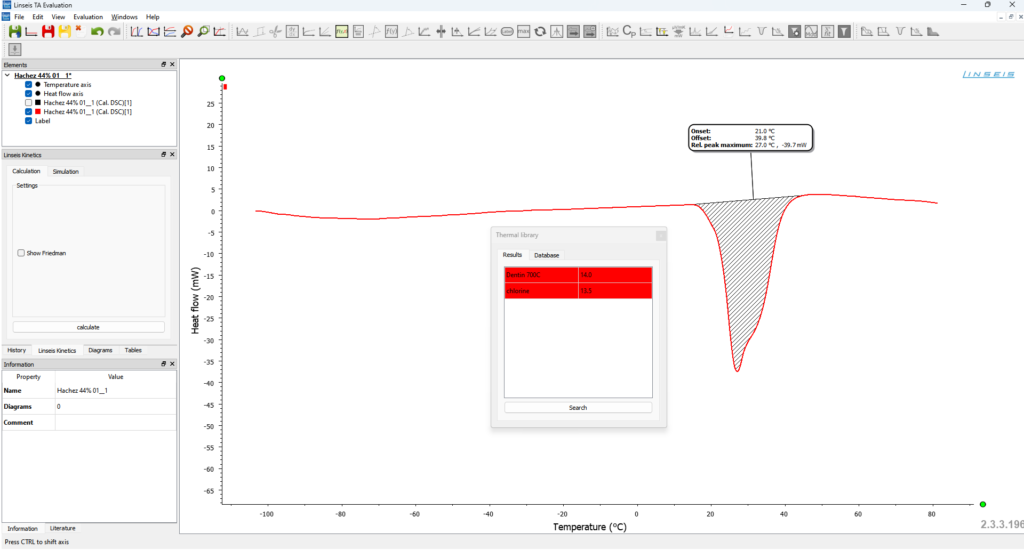
Multi-instrument
All LINSEIS instruments TGA, DSC, DIL, STA, HFM, LFA, etc. can be controlled via a software template.
Multilingual
Our software is available in many different user-interchangeable languages, such as: English, Spanish, French, German, Chinese, Korean, Japanese, etc.
Report generator
Convenient template selection for creating individual measurement reports.
Multi-user
The administrator can set up different user levels with different rights to operate the device. An optional log file is also available.
Kinetic software
Kinetic analysis of DTA, TGA, EGA (TG-MS, TG-FTIR) data to investigate the thermal behavior of raw materials and products.
Database
The state-of-the-art database enables simple data management with up to 1000 data records.
Application
Chemical Industry
Thermogravimetric analysis (TGA) plays a central role in the chemical industry, providing precise information on composition, reactivity, and stability of raw materials, catalysts, and reaction products.
The LINSEIS TGA L87 MSB extends these capabilities through its magnetic suspension balance technology, allowing contact-free measurements under extreme conditions – including high pressure, reactive gases, and wide temperature ranges.
By continuously monitoring mass changes during controlled temperature or pressure programs, the system delivers detailed insight into decomposition, oxidation, reduction, adsorption, and desorption processes.
This makes it invaluable for the development and optimization of chemical reactions, catalyst research, and gas–solid interaction studies under realistic process conditions.
With its ability to operate up to 2400 °C and 350 bar, the TGA L87 MSB provides reliable, reproducible data even in challenging environments.
It supports chemical engineers and researchers in evaluating reaction kinetics, material stability, and sorption behavior, ensuring the highest standards in process safety, product quality, and innovation within modern chemical production and research.
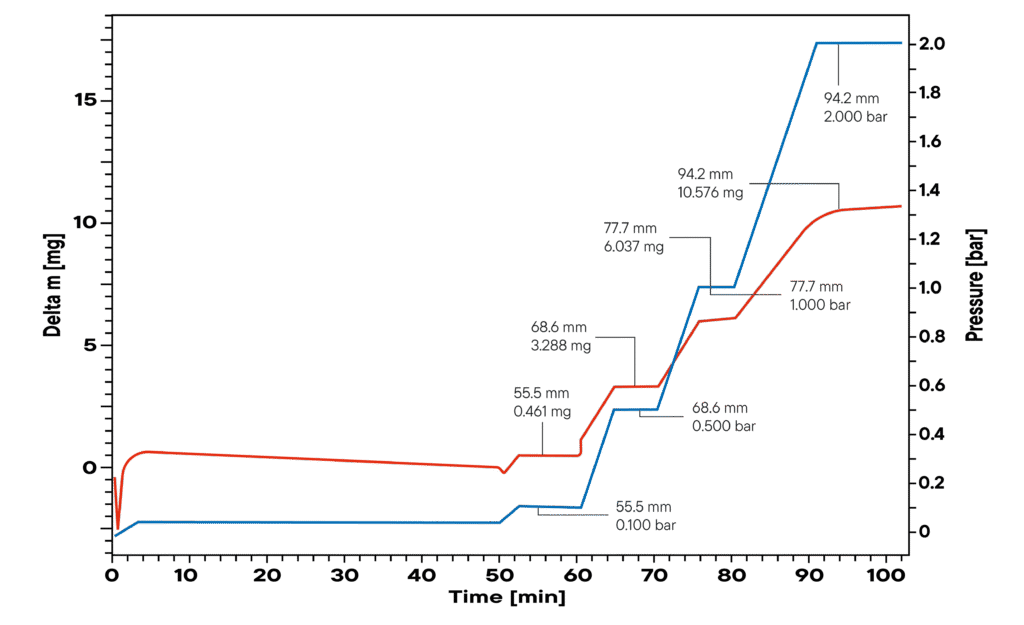
Application example: Isothermal adsorption by Zeolite
The adsorption behavior of a zeolite sample was investigated under isothermal conditions using the MSB L87.
The experiment was performed at room temperature with a stepwise pressure increase from 0.1 to 2.0 bar. At each pressure step, the uptake of gas molecules by the zeolite framework was monitored through the corresponding sample mass increase. The recorded adsorption capacities ranged from 0.461 mg at 0.1 bar up to 10.576 mg at 2.0 bar. The stepwise isotherm clearly demonstrates the high affinity and capacity of zeolite
materials for gas adsorption.
Application example: Catalyst coking
The example illustrates the formation of coke on a catalytic material under process-relevant conditions of 20 bar and 650 °C in a reactive CH₄/H₂O atmosphere. As the steam partial pressure is gradually reduced, the reaction equilibrium shifts toward carbon formation, leading to a continuous mass increase of the catalyst due to coke deposition. The maximum specific coke deposition rate determined from the measurement is 0.32 mg g-1 s-1, highlighting the strong influence of steam concentration on the coking behavior of the catalyst.
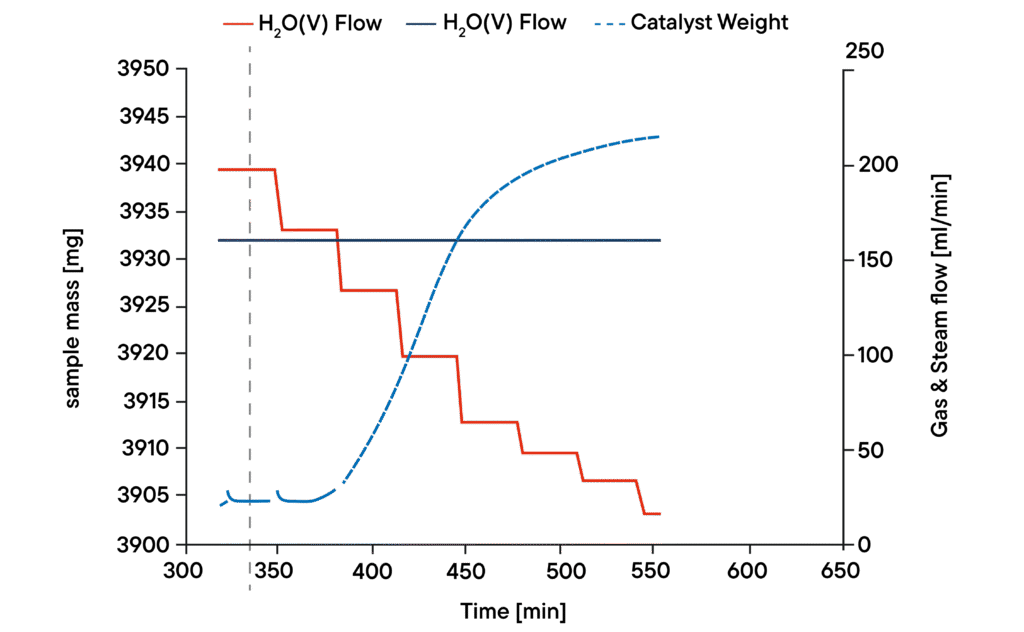
Energy Industry
Thermogravimetric analysis (TGA) is a key technique in the development of modern energy technologies.
The LINSEIS TGA L87 MSB enables highly precise investigations of materials used in energy storage, fuel conversion, and gas purification, even under extreme temperature and pressure conditions.
By continuously measuring mass changes during heating, cooling, or pressure variations, the system provides detailed insights into reaction kinetics, sorption behavior, and thermal stability of fuels, catalysts, and storage materials.
This makes it ideal for studying processes such as biogas upgrading, CO₂ capture, hydrogen storage, pyrolysis, and coal or biomass gasification.
With its magnetic suspension balance technology, the TGA L87 MSB allows contact-free weighing in reactive or corrosive atmospheres up to 2400 °C and 350 bar, ensuring the highest precision and reproducibility.
These capabilities support research and development efforts aimed at improving energy efficiency, sustainability, and process reliability across the energy industry.
Application example: Adsorption of Biogas on Zeolite
The adsorption behavior of biogas components was investigated using the LINSEIS MSB L87.
Pure gas isotherms of CO₂, CH₄, N₂ and H₂ were measured on zeolite, an industrially relevant sorbent for biogas purification. With increasing importance of biogas as an energy source, the purification of its gas components is gaining significance. In combination with an appropriate dosing system, the instrument also enables the determination of gas mixture adsorption. This experiment demonstrates the capability of the MSB for precise sorption measurements under controlled conditions.
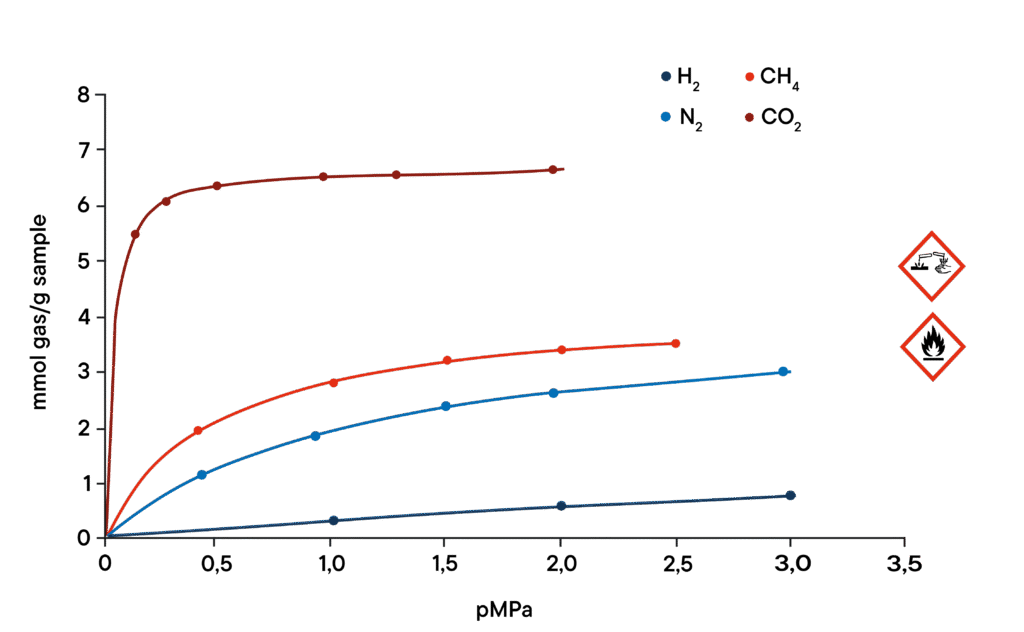
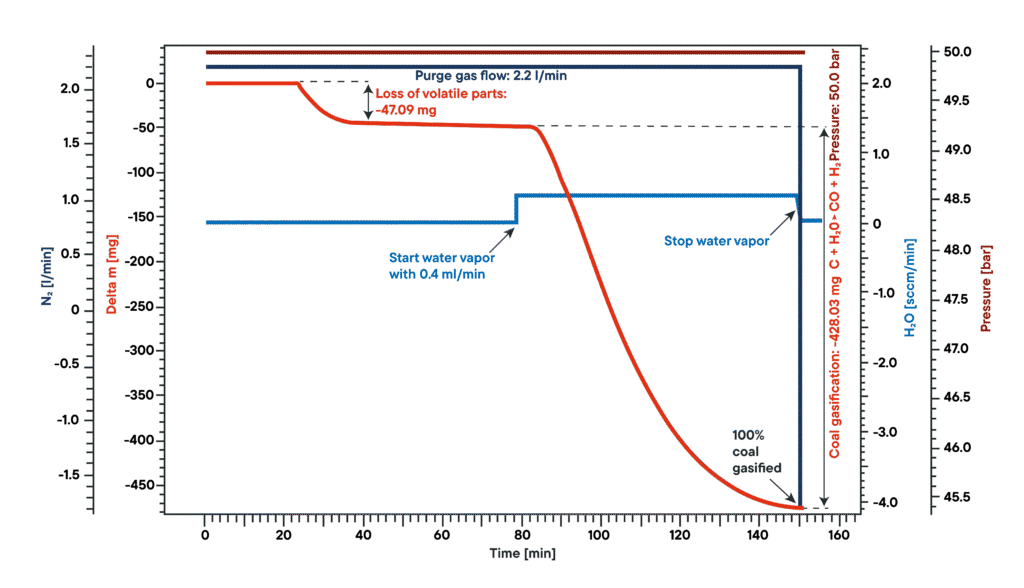
Application example: Coal gasifi cation
The gasification behavior of coal was studied at 50 bar using the
LINSEIS MSB L87 with a purge gas flow of 2.2 l/min. Initially, the release of volatile components caused a mass loss of 47.1 mg. After stabilization, water vapor was introduced at 0.4 ml/min, initiating the coal gasification reaction. The sample showed a continuous mass decrease until complete conversion, resulting in a total mass loss of 428.0 mg. This experiment highlights the suitability of the system for kinetic investigations under high-pressure and reactive conditions.
Well informed

